Rabbits, rival gods, and the father of the first emperor
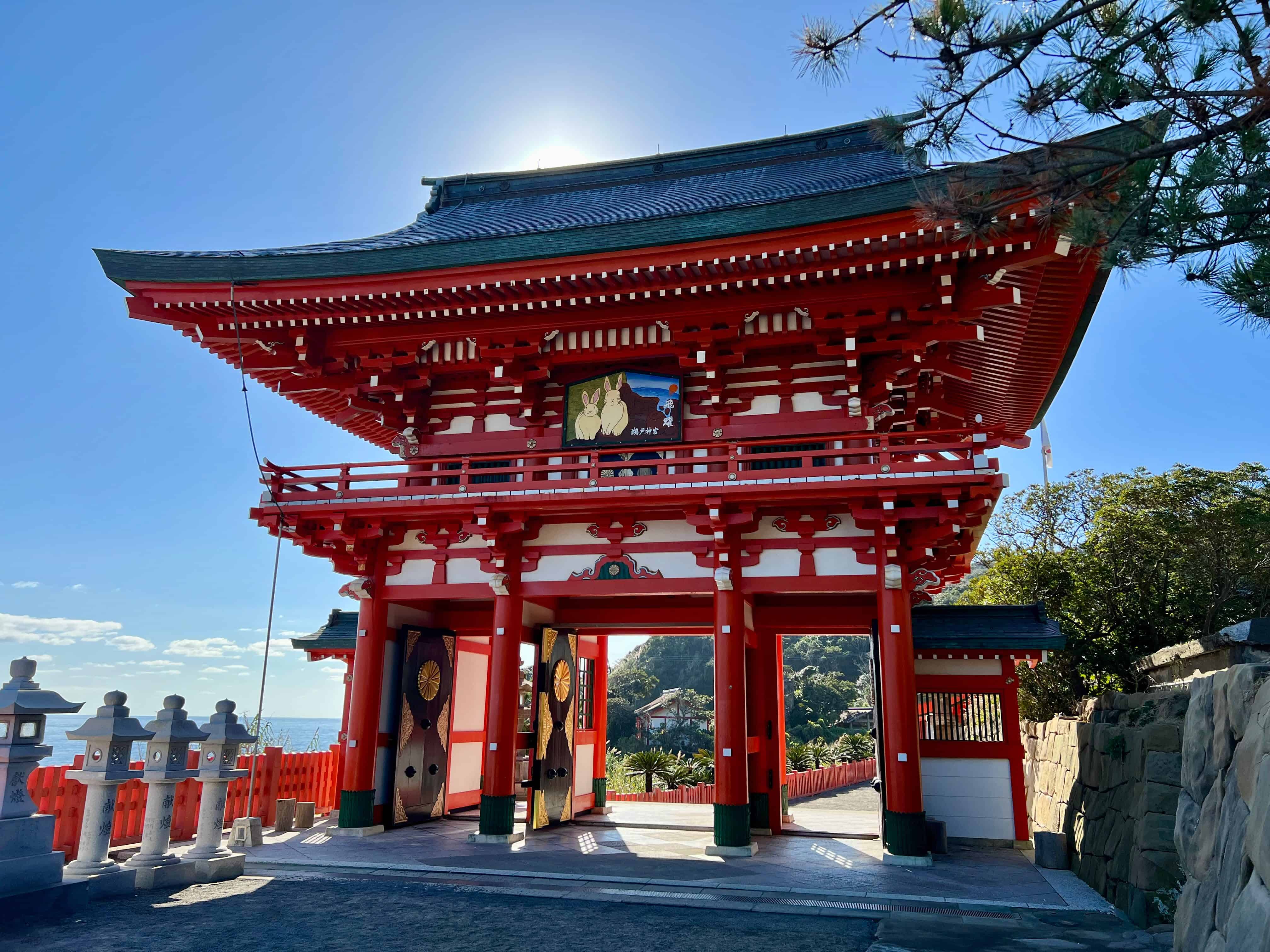
As we walked along the path to Udo Shrine on the Nichinan coast of southeastern Miyazaki Prefecture, the morning sun sparkled on the clear blue sea. It was a beautiful day, and although cold, the sun warmed us.
After passing through the initial torii gate, we soon came to a magnificent two-story vermilion and white gate, much like those that stand at the entranceway to Buddhist temples. Indeed, until the Meiji government forcefully separated Buddhism from Shinto in 1868, this shrine shared its grounds with 18 temples.
A bit further north along the windswept coast, we came across cute statues of rabbits. I stopped to read about them. Curiously, they are the shinshi, 神使, divine messengers of Udo’s illustrious deity who bridge the gap to this world.
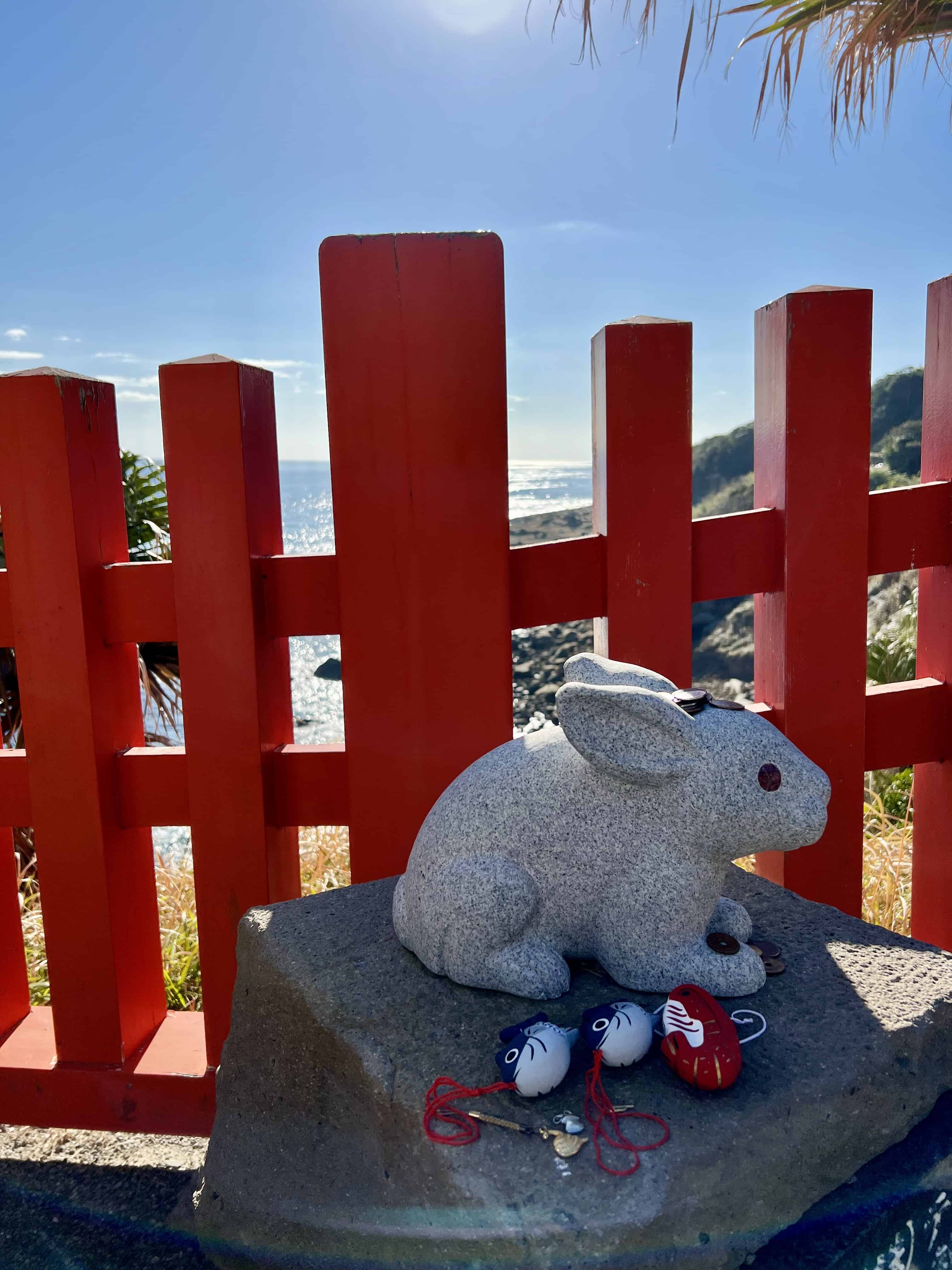
Most Shinto shrines have komainu lion dogs as guardians. Although, there are Shinto deities that have other shinshi animals:
- The more than 30,000 Inari shrines have fox messenger guardians
- The more than 12,000 shrines dedicated to Tenmangu, the God of Learning, have cows
- A few shrines to Wake no Kiyomaro, the Great Protector of the Emperor, have wild boars
- Rare shrines have cats as guardians, such as the Omatsu Daigongen Shrine in Shikoku
- And shrines to Bishamon, the God of Warriors, have tiger guardians, such as the Kurama-Dera Temple, north of Kyoto.
But rabbits? Why does Udo Shrine have rabbits?
To answer that question, we need to go back so far in history that we enter the realm of legend.
The Tale of Two Brothers — Umisachi-Hiko and Yamasachi-Hiko
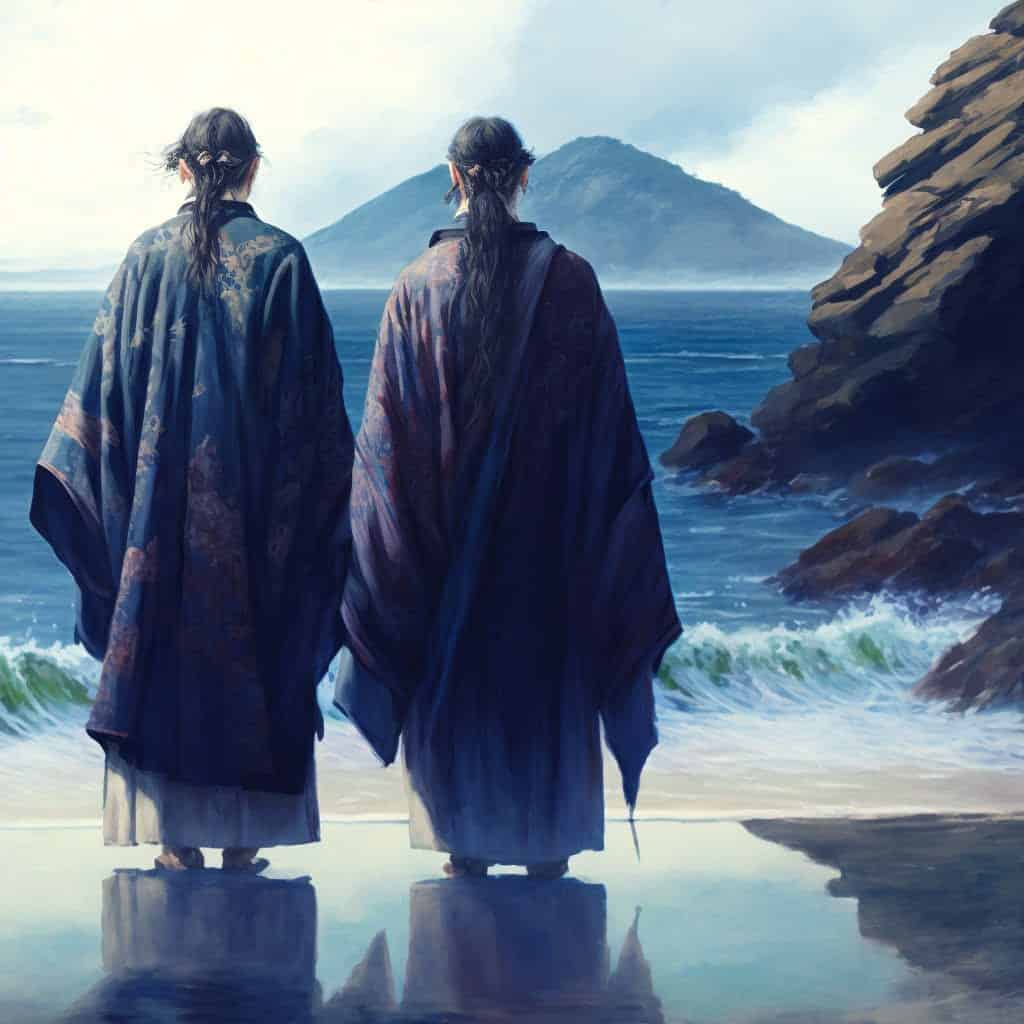
Long, long ago, on the great plains of Heaven, the sun goddess Amaterasu sent her grandson, Ninigi no Mikoto, down to rule over the earth. He descended upon Mount Takachiho, in southern Kyushu.
Ninigi raised his eyes and spied the distant town of Ata in the land of the Hayato. He deemed this a good land and there he settled. He married a lovely maiden, Konohana no Sakuyahime, and they had three sons, two of whom were Umisachi and Yamasachi. Umisachi, whose name means “blessings of the sea,” made his livelihood by harvesting the bounty of the sea, while his younger brother Yamasachi, whose name means “blessings of the mountains” — well, you know.
One day, the younger Yamasachi asked his brother, “How about if we trade hunting tools? You take my spear and I get your fish hook? Please.”
Umisachi brushed him off, but Yamasachi persisted. After Yamasachi pleaded three times, his brother gave in.
Yamasachi, filled with excitement, took his brother’s fish hook and went to the seaside. Hours later, not only had he not caught a single fish, but he lost his brother’s hook.
Meanwhile, Umisachi was off in the mountains hunting. He, too, caught not one animal. He returned to the seaside and met his distraught brother.
“I lost your fish hook in the sea!” Yamasachi blurted out his confession.
This was not good news. Umisachi was enraged. “You find it and give it back!” he shouted.
This seemed an impossible task, so Yamasachi took drastic measures. He broke apart his prized long sword and used it to fashion 500 fish hooks which he presented to his brother.
Umisachi did not accept them.
Yamasachi then made 1,000 fish hooks to give his brother.
Umisachi refused to take them, saying in his petulance, “I want my fish hook.”
In despair, Yamasachi sat by the seaside and dissolved into tears.
The God of the Tides, Shiotsuchi no Kami, passed by and saw his distress. He listened to Yamasachi’s troubles and offered to help. Shiotsuchi built a small boat of tightly woven bamboo and said, “Get in and let the boat follow the tides. It will take you to the gate of the palace of the Sea God. Climb the katsura tree before the gate and wait there. Toyotamabime, the daughter of the Sea God, will help you.”
This Yamasachi did. As he waited atop the tree, a servant of Toyotamabime saw him and went to call her mistress. When Toyotamabime saw the beautiful Yamasachi atop the tree, their eyes locked, and her heart was captured.
She ran to tell her father. Upon setting eyes on Yamasachi, the Sea God recognized him as the son of a god.
He set out skins of sea lions and laid upon them many layers of silk to make a comfortable seat for Yamasachi. The God of the Sea presented a feast to him, after which he gave the hand of his daughter in marriage to the bewildered Yamasachi.
Yamasachi and his wife lived happily in the palace of the Sea God for three years. Then, one day, Yamasachi remembered why he had gone there in the first place.
The lost fish hook.
Recalling his brother’s anger, Yamasachi revisited his former despair. Toyotamabime, seeing his uncharacteristic sadness, went to her father.
The God of the Sea listened to Yamasachi’s troubles. He then called to him all the fish of the sea, asking if any knew of the missing hook.
Rumor among the fish community told of a sea bream with a bone stuck in its throat. They brought the unfortunate fish to the God, and lo and behold, the missing hook was in its throat.
The Sea God washed the fish hook and presented it to Yamasachi. He put a curse on the hook and instructed Yamasachi,
“When you present this hook to Umisachi, tell him, ‘This fish hook muddles the mind and makes its owner poor and foolish.’
“When Umisachi makes rice fields in the mountains, you make them in the valleys. When he makes them in the valleys, you make them in the mountains. I control the water, and your fields will be fruitful while his will be desolate.
“If your brother attacks you, use this orb to raise the sea level and drown him. If he begs for mercy, use this other orb to lower the tides.”
This he said while placing two magical orbs in Yamasachi’s hands.
Yamasachi returned to his land on the back of a shark. He did as the Sea God had instructed him, and he was blessed with three years of bountiful rice harvests. Umisachi, meanwhile, languished in poverty.
Seeing his brother’s good fortune, Umisachi’s anger rose, and, just as the Sea God had instructed, Yamasachi used the orb to raise the sea and drown his brother.
After long struggling in the waves, Umisachi cried out, “I promise to forever serve and protect you.”
Yamasachi used his other orb to lower the sea and rescue his brother. From thenceforth Umisachi and his descendants, the Hayato people, served Yamasachi and his descendants, the Yamato people.
But wait! What about the rabbits?
Udo Shrine’s origin
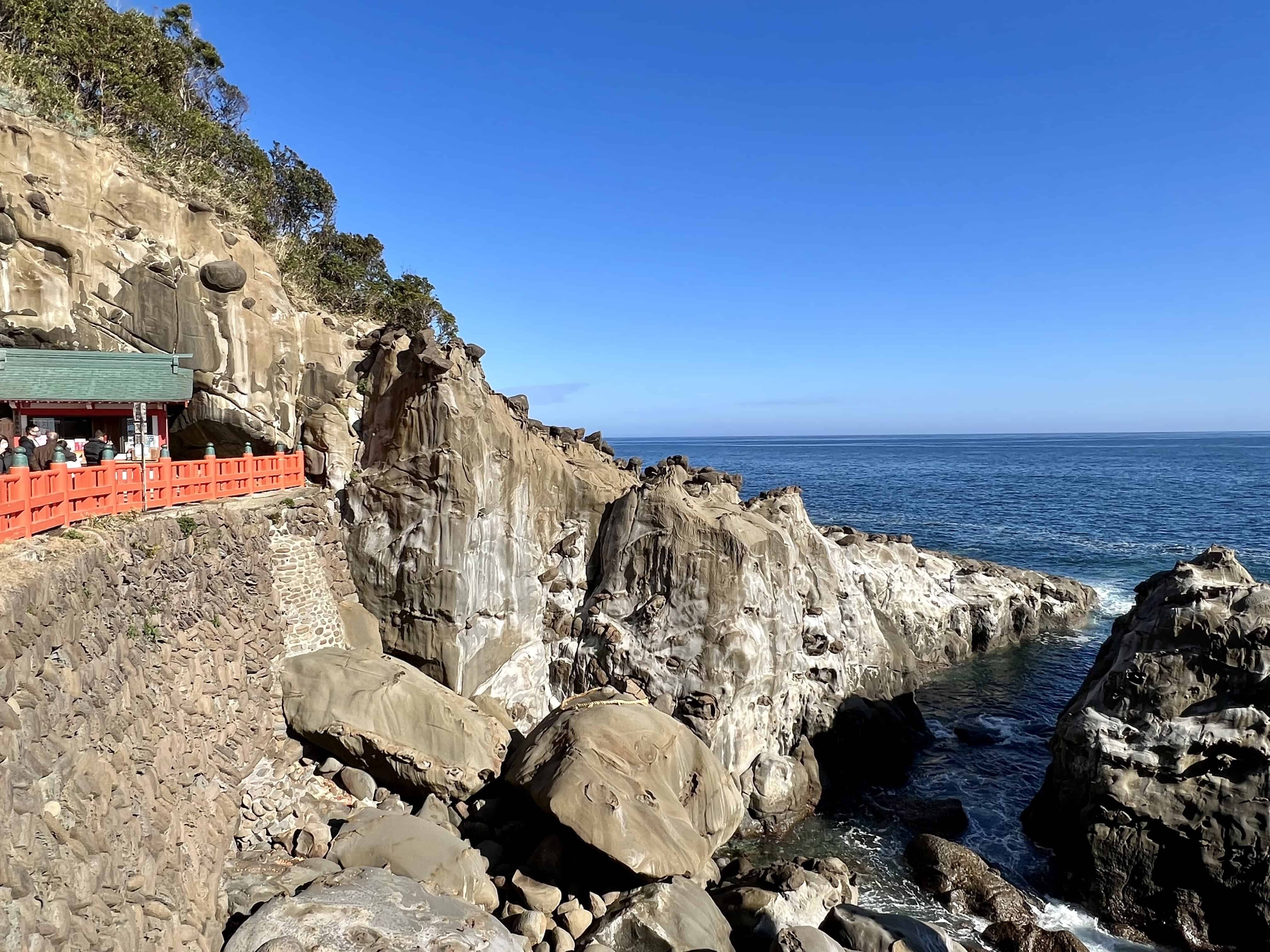
Yamasachi’s wife had gotten pregnant, and as the custom of her people was, she traveled to the shore to give birth. A birthing hut was constructed and was to be thatched with cormorant feathers, but before it was finished, her pains were upon her and she rushed into a cave.
Toyotamabime warned Yamasachi that she would return to her natural form while giving birth, and she made him promise not to look upon her.
Overwhelmed with curiosity, he peeked into the cave. His beloved had transformed into a large crawling, undulating shark. Yamasachi was beside himself. He ran and hid.
Knowing she had been seen, Toyotamabime, in her shame, returned to the sea, but not before exchanging poems of everlasting love with her husband, Yamasachi.
Udo Shrine is built within the cave where Toyotamabime gave birth. Udo, 鵜戸, means “Cormorant dwelling.”
To reach the seashore, Toyotamabime had ridden on the back of a turtle. This turtle has since turned to stone. Beaten by the waves, it has been sanctified and crowned with a shimenawa rope. Those who successfully toss a lucky stone into the indentation on the top will have their wishes fulfilled.
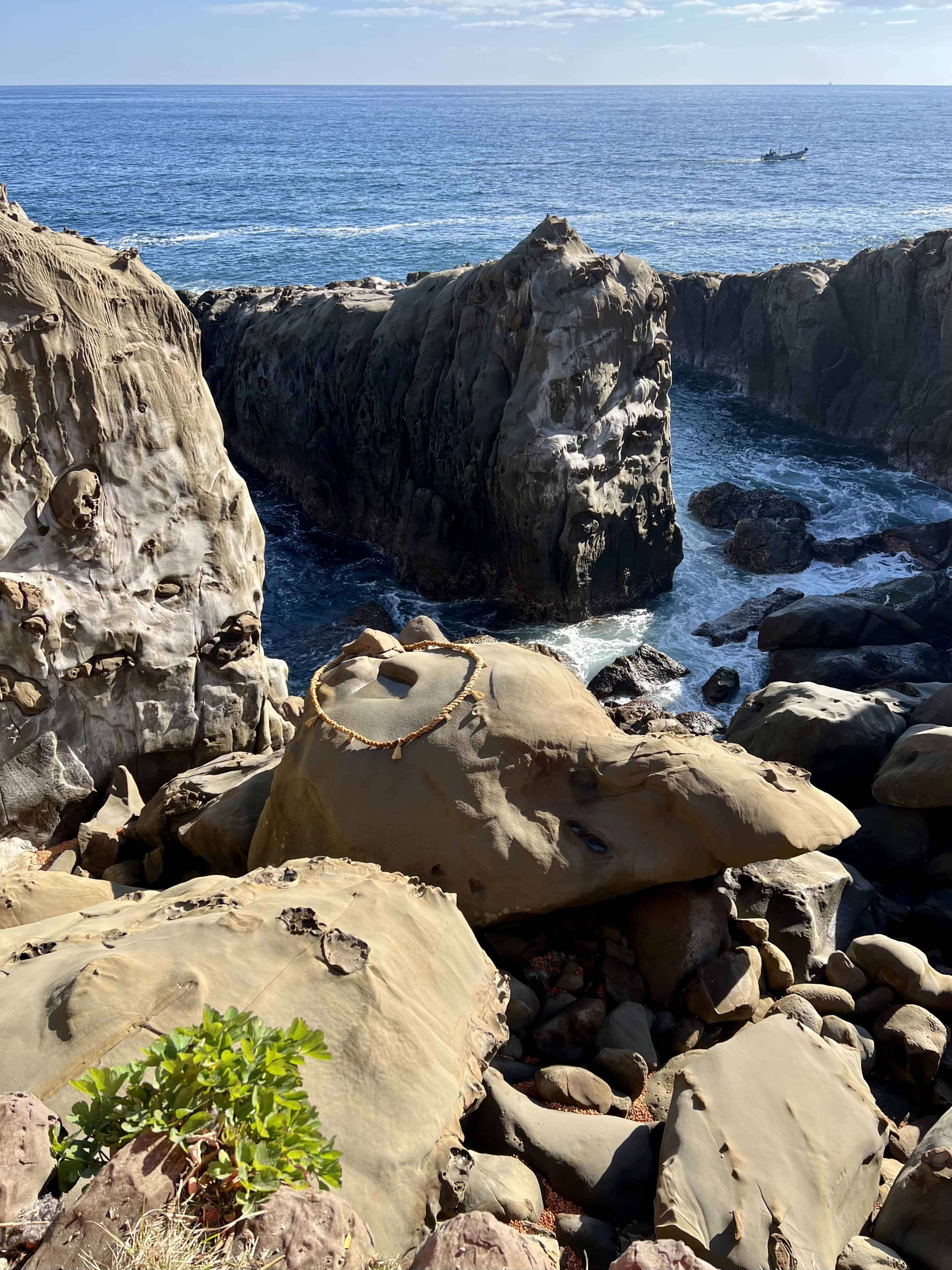
The child born to Toyotamabime and Yamasachi was named Ugayafukiaezu no Mikoto. He eventually married his mother’s younger sister, and they became the parents of Japan’s first emperor, Jimmu.
Ugayafukiaezu no Mikoto, written 鸕鷀草葺不合尊, has the sound “u” at beginning of his name. This “u” is written using the old character for cormorant, 鸕. In ancient Japanese, characters were sometimes used to represent sounds rather than their meanings.
The word rabbit, usagi, when written in combinations is also read “u” — although it uses completely different characters, 兎 or 卯. Sometime way back before the 8th century, this play on words — or characters, if you will — became the reason that rabbits were chosen to serve Ugayafukiawezu no Mikoto at Udo Shrine.
Not as satisfying an explanation as I had been hoping for.
Nade Usagi for healing
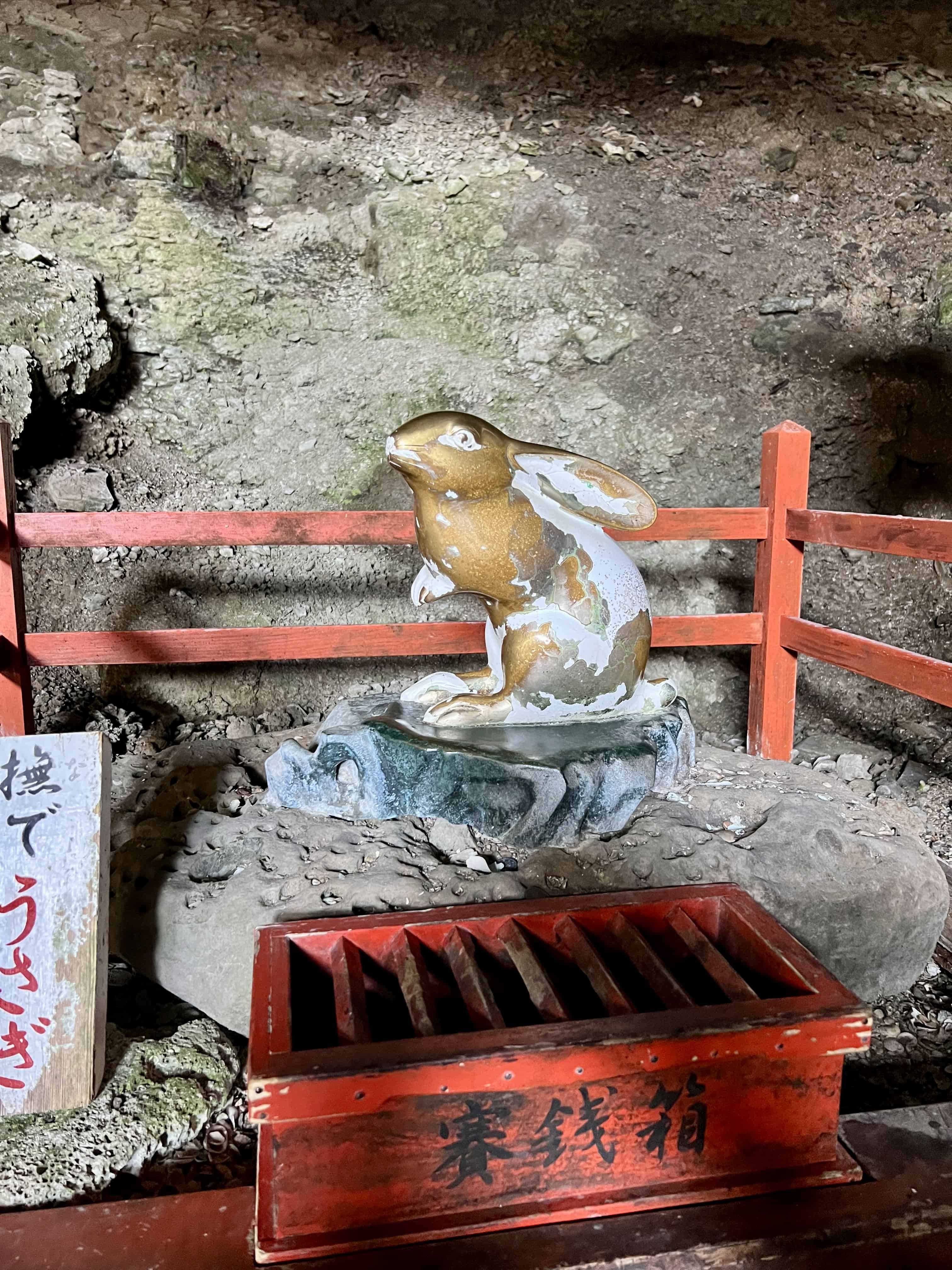
Like the Sasuri Neko cat statue at the Omatsu Daigongen Shrine in Shikoku, Udo Shrine has a Nade Usagi, or stroking rabbit, within its cave. Visitors rub the rabbit’s body to receive healing, stroking its body in the place where they themselves have ailments.
If you are ever in southern Kyushu, I hope you will take the time to seek out Udo Shrine, enjoy the magic of its legends, and explore the beautiful Nichinan coastline.
References:
Udo Shrine signage, the Kojiki, Professor Nakamura.
If you have questions about Japan or suggestions for articles, please add them in the comments. For more photos and information on Japan, follow me on instagram at: https://www.instagram.com/more_than_tokyo/




